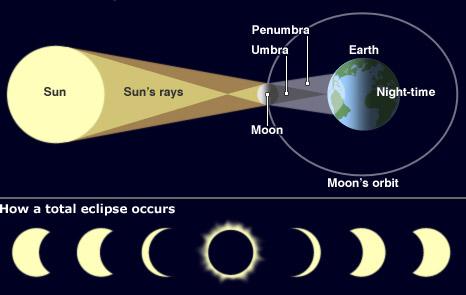Total solar eclipse crosses South Pacific
- Published
A total solar eclipse has crossed the South Pacific, with thousands of tourists and scientists gathered on Chile's Easter Island to witness it.
The eclipse, which was only visible from small sections of land, ended over southern parts of Chile and Argentina.
The eclipse started at 1815 GMT about 700km (440 miles) south-east of Tonga, and reached Easter Island by 2011 GMT.
The population of the island - a Unesco World Heritage site - doubled to about 8,000 for the event.
Some forecasters had warned that cloudy skies could dash hopes of a clear view of the eclipse.
But as the moment neared on Easter Island, stormy weather gave way to bright sunshine .
"It was like being in the stadium at night with artificial light. It was like being in a dark room with a 10-watt bulb," local official Francisco Haoa told AFP news agency.
"It started with a shadow. The skies were perfectly blue, with lots of wind which chased away the clouds. Everyone applauded."
In Tahiti, where the eclipse began, crowds of football-mad Polynesians turned away from the World Cup final on TV to look to the skies instead.
"It was like the Sun was smiling," said eight-year-old Hinanui. "The Sun seemed like a horizontal crescent, then the Moon covered up the bottom of the Sun which reappeared again as a crescent."

Clouds over Easter Island cleared as the eclipse neared
Increased security
A total solar eclipse occurs when the moon passes between the sun and the Earth, blocking its rays and casting a shadow.
The eclipse followed an 11,000km (6.900-mile) path over the South Pacific. The longest time of eclipse - five minutes and 20 seconds - was over the sea.
Easter Island's governor has insisted it can cope with the influx, but there has been increased security at sacred sites, including for the famous Moai stone statues.
The island was partly evacuated after Chile's earthquake in February and the authorities want to show that it is back on the tourist map.
Local mayor Luz del Carmen Zasso told Agence France-Presse news agency: "Easter Island is an open-air museum, and the eclipse is part of this museum."

In the area covered by the umbra (the darkest part of the shadow), a total eclipse is seen
In the region covered by the penumbra (where only some of the light source is obscured) a partial eclipse is seen